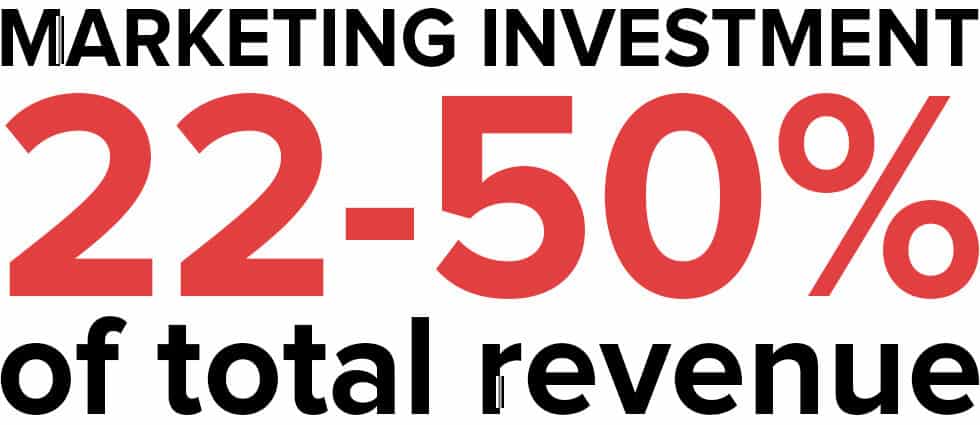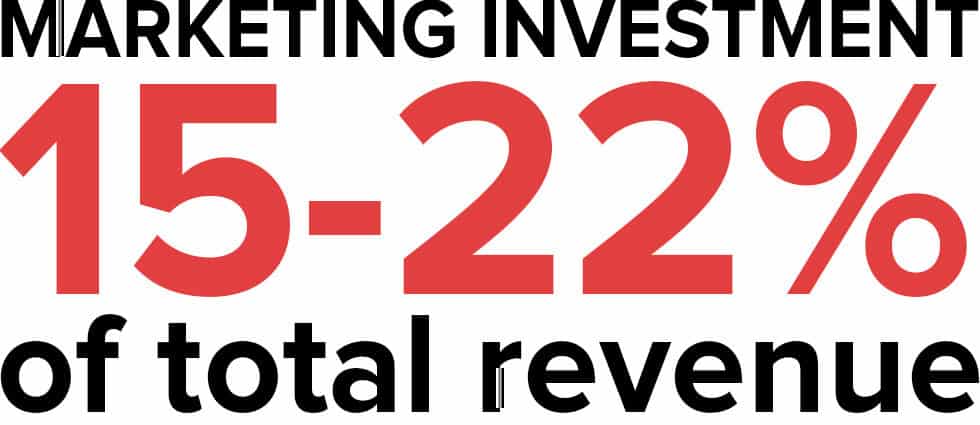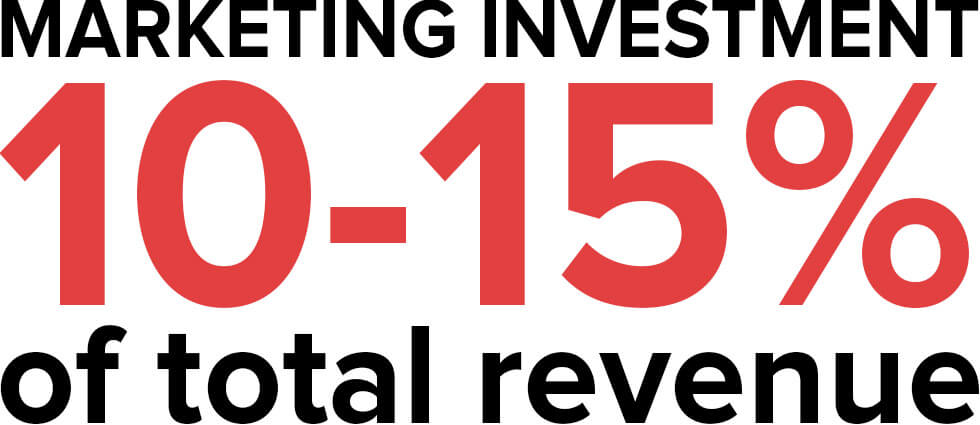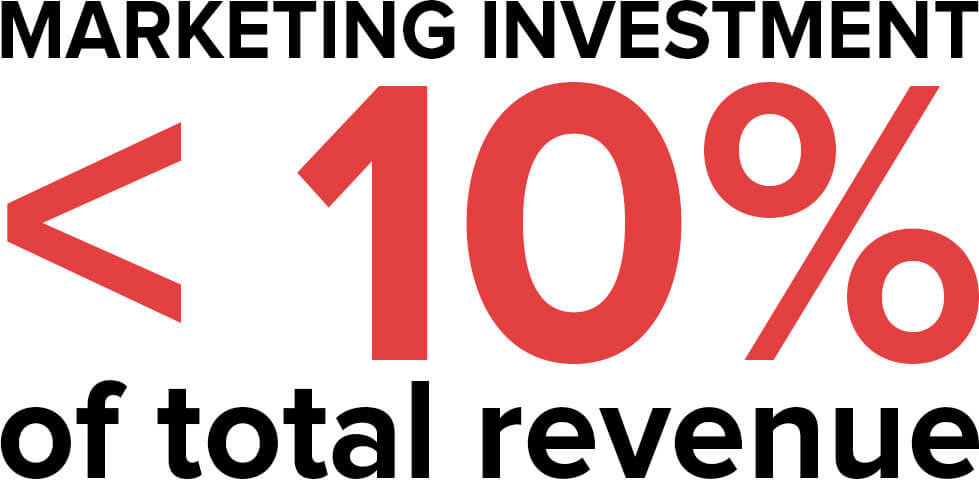Your Marketing Performance Isn’t the Problem…You Are
by Jacob Baadsgaard • May 6, 2020
Fast growth. High margins. Every business wants ’em. I mean, seriously, grow rapidly while making tons of money? Count me in!
Unfortunately, these two goals don’t usually go hand in hand.
To grow, you have to spend money on marketing. The more aggressively you spend, the more aggressively you grow…and the less profitable your campaigns tend to be.
As much as we’d all like to snag massive amounts of market share at incredible profit margins, most businesses have to balance the two.
Do you want to grow? Or do you want to optimize your profit margin?
The right answer really depends on you and your business. But, if you don’t know which matters more to you, you’re going to end up barking up the wrong tree.

I’ve seen businesses overspend (and underspend) on marketing countless times, only to frustratedly throw their hands up and ask, “What am I doing wrong?”
That’s why, in this article, I’m going to walk you through a variety of goals and scenarios that I’ve encountered. We’ll talk about exactly what budget range you should expect to achieve different types of results and the best ways to hit different growth goals.
Sound like a plan? Let’s get started.
Growth vs Profit Margin
Since every business wants both high margins and rapid growth, it’s no surprise that many companies push for both…and end up with neither.
Chasing margins and growth simultaneously is almost always an exercise in frustration. If you’re trying to double the size of your business this year, what do you do with that high-volume, low-profit margin campaign?
To answer that question, you have to understand what your real goal is.
[clickToTweet tweet=”Growth doesn’t mean much in isolation. Understanding WHY you want to grow is the key to figuring out HOW to grow.” quote=”Growth doesn’t mean much in isolation. Understanding WHY you want to grow is the key to figuring out HOW to grow.”]
If you’re trying to grow your business because you’re trying to win over investors (or have them breathing down your neck), profitability may not matter all that much to you. Same goes for a new business, where you’re trying to figure out what works and what doesn’t—even if it means you have to waste some money along the way.
However, if you’re in a comfortable position and you’d like to stay that way, growth may take a backseat to margin. You may be looking to grow, but what you’re really hoping to do is make more money. It doesn’t matter whether that growth comes from increased marketing efficiency or increased market share, you want more dollars in the bank.
Or, maybe you’re somewhere in between these two ends of the spectrum.
In any case, to pick the right marketing budget, you have to understand what your growth and margin goals are. You can’t have it all, so what matters most to you?
To help you answer that question, let’s walk through four different scenarios and their associated marketing budgets to see what approaches resonates best with you and your priorities.
1) High Growth, Break-Even Margin
When you need to grow more than anything else, it’s going to cost you. If you’re willing to go all-in on marketing, you can rapidly capture huge chunks of market share.
But I’ll warn you, it’s going to cost you.
If you’re willing to spend 22-50% of your revenue on marketing, you can see amazing growth. Odds are, it will be barely profitable at best, but it’s a great way to quickly penetrate your target market.

This sort of approach is typically used by entrepreneurs, business owners and investors who don’t care about losing money in the short-term if it means big long-term dividends.
For example, if your goal is to sell your business in the next few months-to-years, this can be a great way to put your company on the map. You may only break even for the foreseeable future, but a big buyout can make it all worth it.
In addition, if you’re investing in a new marketing channel, expect these sorts of results early-on. It takes time and money to get your marketing strategy figured out, so don’t be afraid if you lose a little money at first. It will usually pay off in the long run.
2) High Growth, Low Margin
For most businesses, however, break-even isn’t good enough. You can be patient and wait for things to pay off, but you have to put food on the table.
So, if you really want to grow aggressively, but you need that growth to be sustainable, you’ll want to invest around 15-22% of your revenue into marketing.

This is a much more moderate approach than, say, investing 50% of your revenue into marketing, but it should still leave you with more than enough budget to grow your business.
Will this sort of approach make you a millionaire overnight? No. In fact, you might not even make very much, but you should at least be able to take a decent salary while you wait for things to really pay off.
The good news is, this level of investment is much more sustainable than the break-even approach. Businesses can’t run for very long without making money, so if you’ve got a little profit to work with, you can usually grow for a lot longer.
Most businesses either take this approach when they’re young and hungry or when the owner/investor isn’t sure whether or not they want to sell. They’re feeling out the market and trying to see what their long-term possibilities are.
If the right offer comes around, they might sell…or they might not. They’re trying to build a sustainable business model, after all.
The same sort of thinking applies when you’re first investing in any new marketing channel. At the beginning, you’re testing things out. You don’t expect to make much money, but as you learn, improve things and capture more market share, your profit margins slowly improve and things become more sustainable.
In either case, the goal of this sort of marketing is to grow and prove out your model. You won’t make a ton of money at first, but with time things will get better.
3) Medium Growth, Medium Margin
If growth isn’t your overriding priority, you’ll probably want to dial things back even more. Unless you’ve taken control of your market, you probably still want to grow…but you want to make good money while you’re at it.
Here, a good marketing budget will sit at right around 10-15% of your total revenue.

To be honest, businesses in this situation are some of our favorite clients. When you’re in a stable, profitable position, the world is your oyster. It isn’t a “do or die” scenario, so you can take calculated risks and really optimize every aspect of your marketing strategy.
Most businesses that take this sort of balanced approach are in things for the long haul. They aren’t looking to sell soon. They have a proven, stable business model—now all they have to do is make the most of it.
With new marketing channels, once you reach this point, your marketing starts to take on a life of its own. “Free” channels like referrals and repeat customers start to take off, which frees you up to focus your marketing budget on your most profitable campaigns…and making those campaigns even more profitable.
Once you have solid brand awareness and market penetration, everything gets a lot easier. Growth is easier. Making a decent margin is easier. At this point, you simply need to invest enough to keep up the momentum.
4) Low Growth, Higher Margin
Finally, for some businesses, growth just isn’t all that important. Would they like to grow? Sure, who wouldn’t? But given their command of the market, household name status, financial concerns or other priorities, they’re content to take a “slow and steady wins the race” approach.
However, even for these businesses, it’s still important to keep investing in marketing.
In the world of business, it really is “grow or die”. Churn, new competitors and other market factors are constantly chipping away at your share of the market. If you aren’t actively trying to replace those losses, you’ll soon find that you’re losing out to other, more aggressive companies.
So, if growth isn’t that important to you right now, you’ll still want to invest in marketing, but you don’t need to invest more than 10% of your total revenue.

This approach to marketing generally works best when you’re one of the top dogs in your industry. Once you’re fairly well-established, there may not be that much market share left to capture.
In this situation, it can be challenging to find ways to grow your business without risking what you already have. Can you still discover big growth opportunities? Sure, but your best bet is to test new products, offers, marketing tactics or channels quickly and aggressively.
If it works at an acceptable profit margin, dive in! If not, get out quick and try something else.
In general, whether you’re a new entrepreneur or trying a new channel for a mature business, this is the point where you really make your money. You know what works and what doesn’t…and you can focus your efforts on the things that drive the most profitable revenue.
It’s a great place to be. Just make sure that you don’t get sloppy and complacent…or the competition will be knocking at your door before you know it.
Conclusion
In the end, the right marketing budget for your business depends on your growth goals and what you’re trying to accomplish as a business.
If you’re launching a new marketing campaign, just starting your business or trying to prove your model, a high growth, low margin strategy could be perfect. If you’re more established, you may want to opt for lower growth and better margin. It all really depends on what you’re hoping to achieve.
Can you realistically shoot for high growth and high margin? Not really, but if you understand what really matters to your business right now, you can come up with a strategy that will get you the results you need.
By the way, if you’d like help picking the right growth goals and a marketing budget to achieve those goals, let us know here or in the comments. We’d love to help.
How do you pick your growth goals and marketing budget? Have any tips to add to this article? Leave your thoughts in the comments.





